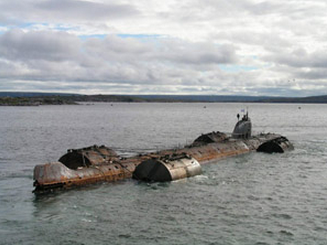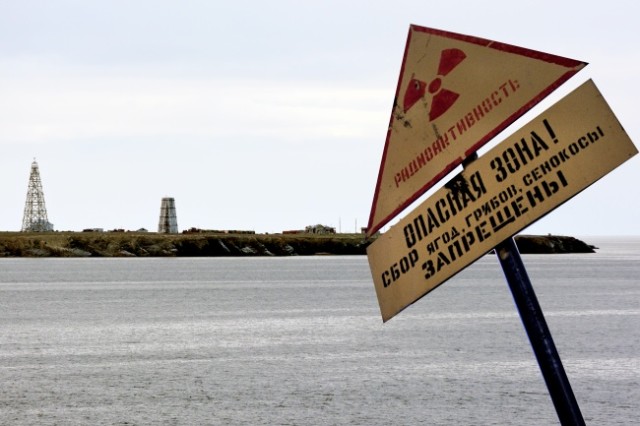
New Managing Director for Bellona Norway
The Board of the Bellona Foundation has appointed former Minister of Climate and the Environment Sveinung Rotevatn as Managing Director of Bellona No...
News

Publish date: April 3, 2014
News
MURMANSK – Two derelict Soviet-era nuclear submarines lying at the bottom of the Barents Sea present a real radiological risk to surrounding waters and could have a negative impact on the delicate ecosystems of Arctic Seas, leading Russian scientists and Russia’s Ministry for Emergency Services have said.
The two subs in question – the K-159 and the K-27 – lay on the ocean floor, the first at the entrance to Kola Bay and the second in the shallows surrounding the Novaya Zemlya Archipelago, a former nuclear bomb testing range during Soviet times, as well as something of a dumping ground for Cold War legacy nuclear waste.
The K-27 submarine was scuttled in 50 meters of water in Stepovogo Bay of the Novaya Zemlya Archipelago in the Kara Sea in 1981 after a serious reactor accident that killed nine. Its reactors contain 90 kilograms of uranium 235.
The K-159, decommissioned in 1989, was swamped in far deeper waters and carrying 800 kilograms of nuclear fuel in its two pressurized water reactors in August 2003 while being towed from Gremikha, a former naval base, to the Polyarny shipyard, where it was to be dismantled. Nine support crewmembers who were onboard to essentially plug leaks while the vessels was under tow, died.

The long dormant conversation about raising the subs has been reanimated because of the recent joint workshop held by Russian state nuclear corporation Rosatom and Bellona last month in Murmansk, where the Russian side expressed its wish to see the vessels retrieved.
Yet, the subs are hardly all of the radioactive hazards languishing at the bottom of the Kara Sea.
According to the Norwegian Radiation Protection Authority (NRPA), other submerged radiation hazards include 19 ships containing radioactive waste; 14 nuclear reactors, including five that still contain spent nuclear fuel; 735 other pieces of radioactively contaminated heavy machinery and 17,000 containers of radioactive waste.
Bellona Murmansk director Andrei Zolotkov said an international dialogue about raising radioactive Russian military machinery 20 years ago would have been impossible.
But the overwhelming tally of international cooperative successes on radiological and nuclear hazards in Northwest Russia are, he said, immeasurable. As such, the conference has opened the door for a joint Norwegian-Russian inspection, particularly of the K-159 submarine, later this year.

“Doubtless, we need to have a serious conversations and consultations on liquidating the Cold War legacy, and sunken subs is an example of such further conversations,” he said. “This is especially important at the moment when many countries and companies are preparing large-scale oil recovery projects in the Arctic.”
Dangers near Murmansk and Finnmark
The K-159 is located near Kildin Island at the mouth of Kola Bay, where it has been located for 11 years, in the midst of rising shipping activities along the Russian and Norwegian coasts.
The Norwegians are not fond of these circumstances, and have insisted on joint Russian-Norwegian investigations of the foundered sub.
The joint expedition to the K-159 will aim to discover its condition and assess whether the radioactive condition of its hull has worsened over the past seven years, when the last expedition to inspect the sunken radiological hazards took place.
The results of the upcoming expedition will largely determine what further steps must be taken, but Russian specialists are already optimistically speaking of raising the sub – promises that have been made and broken before.
According to Andrei Korolyov, first deputy director of Moscow’s Kurchatov institute, the K-159 must be raised before all other sunken nuclear ships and reactors in the Kara Sea.
“It’s the most dangerous for many reasons – it sank quickly with no preparation, and therefore we can speak of radiation dangers within the hull of the vessel,” he told Bellona. “Added to that, it sunk right at the mouth of Kola Bay, an active fishing area.”
The radiological archipelago
The Bellona-Rosatom workshop reinvigorated discussion about radiological research surrounding the Novaya Zemlya archipelago, were the Soviets scuttled tons of solid radioactive waste and vessels containing spent nuclear fuel.
The task of past expeditions to this Davy Jones’ locker of radioactive debris has been to inspect sunken reactor cores, ships and containers of solid radioactive waste for leaking radionuclides, as well as to search out other radiation hazards that have not been charted – something Korolyov told the international gathering.
“We have to continue searching for what is lost,” he said, and citing that previous searches for barges loaded with reactor chambers have been unsuccessful, though they are assumed to be in the waters surrounding Novaya Zemlya.

A previous joint Russian-Norwegian expedition undertaken in September 2012 to the Kara Sea dumping spots revealed that the condition of containers of solid radioactive waste, vessel reactor chambers and dumped fuel assemblies from nuclear icebreakers had not gotten any worse since when they were last inspected, and were causing negligible environmental damage.
The K-27 submarine, however, was a cause for alarm. Sunk in 50 meters of water in Novaya Zemlya’s Stepovogo Bay, the vessel contains 180 kilograms of spent nuclear fuel. The expedition produced video footage of the vessels port side and hull, which led researchers to the conclusion it could be raised.
“We think this needs to be done,” said Mikhail Korbinsky the director of Nuclear Safety Institute of the Russian Academy of Sciences (known by its acronym IBRAE). “This is highly enriched uranium, practically weapons grade, and to leave in in 50 meters of water for the next generation is just unacceptable.”
This year’s expedition will have as one of its focal points new tests to determine if radionuclides are being released from the vessel. Last year’s joint Russian-Norwegian expedition determined that releases were too low to have any environmental impact.
But Korbinsky emphasized that the vessel needs to be dragged up as soon as possible lest international cooperation between Russia and the nations that have assisted it begin to fray.
This article was written by Alexey Pavlov and Charles Digges (charles@bellona.no)

The Board of the Bellona Foundation has appointed former Minister of Climate and the Environment Sveinung Rotevatn as Managing Director of Bellona No...

Økokrim, Norway’s authority for investigating and prosecuting economic and environmental crime, has imposed a record fine on Equinor following a comp...

Our op-ed originally appeared in The Moscow Times. For more than three decades, Russia has been burdened with the remains of the Soviet ...

The United Nation’s COP30 global climate negotiations in Belém, Brazil ended this weekend with a watered-down resolution that failed to halt deforest...